✓ Accommodations ✓ Flights ✓ Rental Cars
Imagine stepping into a temple complex that’s been reclaimed by the jungle, its ancient stones whispering tales of a long-forgotten capital. Koh Ker, a site beyond Angkor, offers just that – a serene escape into Cambodia’s rich history and culture. As the former capital under King Jayavarman IV in the 10th century, this archaeological site is a treasure trove waiting to be explored.
Unlike the crowded temples of Angkor Wat, Koh Ker invites you to explore its ancient temples in peace, revealing unique architectural elements and a glimpse into the Khmer Empire’s glorious past. As your guide to this hidden gem, we’ll walk you through the best things to do in Koh Ker, ensuring your visit is nothing short of unforgettable.
Discovering Koh Ker: Cambodia’s Hidden Temple City
Beyond the crowds of Angkor Wat, Koh Ker stands as a testament to the Khmer Empire’s rich history and architectural prowess. This hidden temple city invites you on a journey of discovery, where ancient ruins and temples await exploration.
The Historical Significance of Koh Ker
Koh Ker is more than just a collection of ancient temples; it’s a window into Cambodia’s past, showcasing the Khmer Empire’s grandeur. For history enthusiasts, Koh Ker offers a unique experience that is both educational and awe-inspiring. The site’s historical significance is palpable as you wander through its ruins, imagining life in a bygone era.
Why Visit Koh Ker Instead of Just Angkor Wat
While Angkor Wat is undoubtedly a must-visit destination, Koh Ker provides a more intimate and authentic experience. Here, you can explore ancient temples without the crowds that characterize Angkor Wat. The journey to Koh Ker is part of the adventure, taking you through rural Cambodian landscapes and villages that offer a glimpse into local life beyond Angkor.
- Enjoy a more serene and peaceful experience, far from the crowds.
- Explore temples in a more natural state of preservation.
- Capture dramatic photos without other tourists in the frame.
- Gain a deeper understanding of the Khmer Empire’s history and architecture.
Visiting Koh Ker is not just about seeing another temple; it’s about embarking on an adventure that enriches your understanding of Cambodia’s rich cultural heritage.
How to Get to Koh Ker from Siem Reap
Koh Ker, a hidden gem in Cambodia, is accessible from Siem Reap via various transportation methods. You can choose from private taxis, shared shuttle services, or even rent a car for the day. The journey takes around 3-4 hours depending on the road conditions and your chosen mode of transport.
Transportation Options and Costs
Several transportation options are available from Siem Reap to Koh Ker, including private taxis and shared shuttle services. The cost varies, with private taxis being more expensive but offering flexibility. Shared shuttles are a more budget-friendly option. You can expect to pay around $60-$80 for a private taxi for the day, while shared shuttle services cost approximately $15-$20 per person, one way.
Best Time to Visit and Practical Tips
The optimal time to visit Koh Ker is during the dry season from November to March. Early morning visits are recommended to avoid the midday heat. When planning your trip to Cambodia, consider packing essentials like water, sun protection, and comfortable shoes. Hiring a local guide can enhance your adventure by providing historical context and pointing out details you might otherwise miss.
- The optimal time to visit Koh Ker is during the dry season from November to March.
- Early morning visits (arriving by 8-9 am) are recommended.
- Pack essentials including plenty of water, sun protection, insect repellent, and comfortable walking shoes.
- Consider hiring a local guide at the site (approximately $15-20).
By planning your visit carefully, you can make the most of your trip to Koh Ker and enjoy the many things to see and do in this ancient temple complex.
Top Temples to Explore in Koh Ker
With over 200 temples, Koh Ker is a treasure trove of ancient structures that showcase the rich history of Cambodia. As you explore this complex, you’ll discover a mix of well-preserved and ruined temples, each with its unique charm.
Prasat Thom: The Impressive Pyramid Temple
Prasat Thom is one of the most iconic temples in Koh Ker, known for its impressive pyramid structure. This ancient temple is a testament to the architectural prowess of the Khmer Empire.

Standing tall, Prasat Thom is a significant historical landmark that offers insights into the region’s past. Its pyramid design is reminiscent of other ancient Khmer structures, highlighting the cultural and architectural heritage of the empire.
Prasat Krahom: The Red Brick Temple
Prasat Krahom, or the Red Temple, is another must-visit site in Koh Ker. Its striking red brick construction sets it apart from other temples in the complex.
This temple is not only notable for its architecture but also for its historical significance, providing a glimpse into the religious practices of the time.
Prasat Neang Khmau: The Temple of the Black Lady
Prasat Neang Khmau, or the Temple of the Black Lady, is a fascinating site that adds to the mystique of Koh Ker. The temple’s unique name is steeped in local legend.
The Black Lady temple is an example of the rich cultural tapestry of Koh Ker, with stories and myths that have been passed down through generations.
Other Notable Shrines and Structures
Beyond the main attractions, Koh Ker is home to numerous other shrines and structures, including Prasat Bram, Prasat Chen, and Prasat Pram, each with its unique features and historical significance.
As you explore these lesser-known sites, you’ll gain a deeper understanding of the Koh Ker complex and its importance as a historical and cultural place. The presence of lingams in many of these temples highlights the Shaivite Hindu worship that was prevalent in the region.
Koh Ker, Cambodia: Best Things to Do – Top Picks
Koh Ker, Cambodia, is more than just a historical site; it’s a place where you can experience the country’s culture, meet its people, and enjoy its natural beauty. As you plan your visit, there are several top picks to consider for a memorable trip.
Exploring the Ancient Ruins
The ancient ruins of Koh Ker are a must-visit, with Prasat Thom being a highlight. This impressive pyramid temple is a testament to the architectural prowess of the ancient Khmer civilization. As you explore the ruins, you’ll be surrounded by the remnants of a bygone era, offering a glimpse into Cambodia’s rich history and culture.

Photography Opportunities
Koh Ker offers numerous photography opportunities, from the intricate carvings on the temple walls to the serene landscapes surrounding the ancient structures. The golden light during sunrise and sunset provides the perfect backdrop for capturing stunning images. Whether you’re a professional photographer or an enthusiast, Koh Ker is a paradise for capturing memorable shots.
Experiencing Local Culture Around Koh Ker
Engaging with the local culture is a significant part of the Koh Ker experience. You can visit the small villages surrounding Koh Ker to observe rural Cambodian life, interact with local vendors, and learn about ongoing conservation efforts. Consider arranging a homestay in a nearby village through community-based tourism initiatives, allowing for deeper cultural exchange.
| Cultural Experience | Location | Benefits |
|---|---|---|
| Visiting local villages | Surrounding areas of Koh Ker | Authentic cultural experiences |
| Interacting with local vendors | Temple entrance | Supporting local economy |
| Homestay programs | Nearby villages | Deeper cultural exchange and economic benefits to local families |
Planning Your Visit: Essential Information
Before heading to Koh Ker, understanding the basics can significantly enhance your adventure. Located 120 km from Siem Reap, Koh Ker makes for an ideal day trip. To plan your visit effectively, it’s essential to know the entrance fees, opening hours, and what to bring.
Entrance Fees and Opening Hours
Koh Ker is open daily from 7:00 AM to 5:00 PM. The entrance fee is part of the Angkor Wat ticket, which offers a one-day, three-day, or seven-day pass. Choosing the right pass depends on your itinerary, including potential visits to other Angkor temples.
What to Bring and Wear
Comfortable clothing and sturdy shoes are a must for exploring the ancient ruins. Don’t forget sun protection, including a hat, sunglasses, and sunscreen. Bringing water and snacks will also keep you energized throughout your visit.
Combining Koh Ker with Other Nearby Sites
Many visitors combine Koh Ker with a visit to Beng Mealea temple, creating a full-day excursion. For those with more time, consider an overnight stay in Sra Em to visit Preah Vihear the following day. Tour operators in Siem Reap offer various combination packages, including the popular Koh Ker and Beng Mealea day trip. You can also plan a multi-day circuit from Siem Reap that includes Koh Ker, Preah Vihear, and Banteay Chhmar before returning to Angkor.
Conclusion: Why Koh Ker Should Be on Your Cambodia Itinerary
Koh Ker, a hidden gem beyond Angkor Wat, offers a captivating glimpse into Cambodia’s ancient past. As the former capital of the Khmer Empire, it’s a must-see for anyone exploring Cambodia.
Visiting Koh Ker provides a more complete understanding of the Khmer Empire’s architectural evolution and historical narrative. The journey from Siem Reap to Koh Ker takes you through rural Cambodia, offering glimpses of everyday life far removed from the tourist centers of Siem Reap and Phnom Penh.
With its unique pyramid temple, Prasat Thom, and other notable shrines, Koh Ker is an ideal destination for those interested in history and culture. As infrastructure continues to improve, now is the ideal time to experience Koh Ker’s mystical atmosphere before it potentially joins the ranks of Cambodia’s more developed tourist destinations, much like Preah Vihear.
The above is subject to change.
Check back often to TRAVEL.COM for the latest travel tips and deals.






